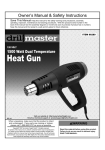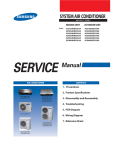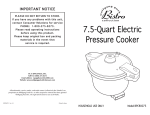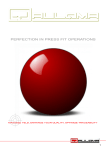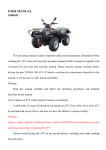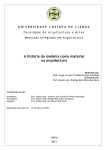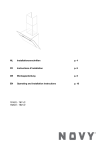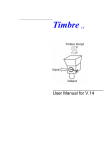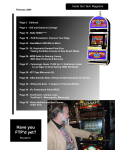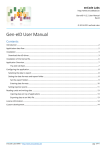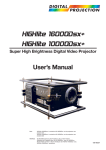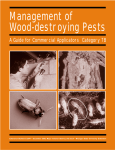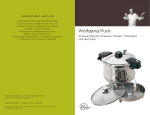Download Report - Aangenamerbouwen.nl
Transcript
Report # Page Date Author WIS-Report English (specimen) 1 / 16 2015-01-04 Robert 't Jong © Rapport naar aanleiding van inspectie van het object Jan Ravestraat 74 1000 AP Amsterdam Circumstances During Inspection Buyer present ? apartment in use ? Weather conditions : no : no : dry, approx. 1°C (last rain < 48 hrs ago) For Terms & Conditions on Woning Informatie ServiceTM please visit our website www.aangenamerbouwen.nl Report # Page Date Author WIS-Report English (specimen) 2 / 16 2015-01-04 Robert 't Jong © Buy Well-Informed ! Purpose of our woning informatie serviceTM is to give you – the would-be owner – the best possible insight in the technical quality, properties and condition of the property you wish to buy. Background & Scope Of Our Opinion & Report Onyour demand we recently inspected the property you aim to buy1). As long as the property is not yours, you nor I are allowed to conduct a visual inspection, without inflicting any damage to the property, so our scope of observation and research is just as limited as yours. Yet, with the proper experience – in my case having inspected some 12.000 objects over the past 26 years – I will most likely “read” the property somewhat different then you. Signals that you may miss may likely catch my eye and where for you it is virtually impossible to guess the reason behind a crack in the wall, I have a far better chance to actually do so. Of course there will be signals that even I will not be able to interpret properly; if then I will advise you to have a specialist conduct extra – regrettably often quite expensive and probably destructive – investigations. Furthermore one should acknowlegde that technical inspection of properties is no exact science. There is no dedicated schooling, nor are there commonly accepted guidelines and standards 2), so different inspectors may adjudge the same situation quite differently. The information and advice in this report is based mainly on secundary signals found in and around the property (most of the important constructive parts are conceiled !), presented drawings, photos and paperwork of an eventual Owners Society; obtaining information from sources outside of the property like e.g. communal archives is – except when specifically stated otherwise – not part of our accepted assignment. Because of this limited scope of investigation, our opinion is also limited and – due to the increasing chance of changes over time – the validity of this report is limited to 6 months after inspection. Our SECURITY-TEXT woning informatie serviceTM will base its opinion and advice on the following questions : "is the property as shown suitable for its projected use ?" and "are there (signals that indicate) severe technical problems that will have to be mended to ascertain the safety and projected functionality of the property ?" Apart from that we will of course advise you on wether the property is well-maintained and for wich parts you will have to make a reservation because it is likely te be mended/replaced within the next 73) years after purchase. All advice is based on "proper home-owners care", i.e. "do what has to be done when it needs to be done without exaggeration". Our advice only sees at those parts that may be adjudged objectively, i.e. al those parts that are either constructive, or part of the climate-seperating shell or – in case of an appartement – communal, like foundations, basement, floors, stairs, constructive walls, façades including window-frames and roofs, seperately and/or in their context. These are the parts that most owners rather not spend to much money on and that for a layman are hard to adjudge. Other parts, like seperations, inner doors and frames, kitchens, bathrooms and finishings in general are not within the scope of our inspection, for they are largely subject to taste and will be exchanged or redone anyway when you move in, whatever their quality and condition... we gladly leave the verdict on those parts to you ! Installations also are not within the scope of our inspection, for inspection and testing of installations may only be done by certified installers, which we are not. This report does contain information about the installations, but that information is not necessarily complete and we may not be held liable for it. There is however one party that knows if installations work : the selling owner ! Ask him/her if he knows of any malfunctions ! And if still in doubt : let certified installers check the installations (with the conscent of the owner of course ...). 1) Unlike most collegues we specifically use the term "inspection" in stead of "keuren" ! "Keuren" means "establishing wether the object meets to your expectations"... we gladly leave that up to you, after all it will be your property, not ours. Building rules & regulations like the “Bouwbesluit” are primarily aimed at new buildings; existing buildings – even if they are only 10-15 years old – will never be in full compliance with the latest version, yet they may be perfectly fit for their projected use. 3) The likelyhood that you will still live in the property deminishes over the years, just like the accuracy of our predictions regarding life-span of materials used. 2) For Terms & Conditions on Woning Informatie ServiceTM please visit our website www.aangenamerbouwen.nl Report # Page Date Author WIS-Report English (specimen) 3 / 16 2015-01-04 Robert 't Jong © Our Inspection Is No Guarantee... With our order-confirmation, via our website or via your agent you were already confronted with our Terms & Conditions, yet – since we want to be absolutely clear about it – we will repeat this here again : Our Inspection is NO Garantee or Insurance against Structural Damage ! As far as we know in the Netherlands no insurance company offers a policy that covers the risk of structural damage in existing buildings, simply because – based on the information that comes available without destructive research – they cannot perform proper risk-assessment. We do not pretend to be smarter than an insurance company and our aim is not to assume liability for the risks that come with the property YOU wish to purchase... after all it will become YOUR property, not ours ! What we can do is help you fullfill your legal obligation to do proper research on the property, in order to make sure that you have the best available information before you decide to buy it. And of course you may assume that we will – within the limits of a visual inspection – conduct this research as good as possible. Some people seem to think that we are able to discover "hidden defects", but alas, that is a myth... even we cannot look through finishings and we are not allowed to inflict any damage or take the property apart ! For "hidden defects" the seller may be held liable, but be aware that not every hidden property legally is a “hidden defect”... Yet, should you discover any defects or malfunctions once the ownership of the property is transferred and you try to hold the seller liable for it, you position will be stronger with our report than without it. For who wants to buy without risk we have but one good advice though : take a lease, don't buy ! Is It The Right Property For You ? The majority of the disappointments with new house-owners has but one reason : improper expectations ! A building from say the 1930s does not have the same properties as a building from the 2000s and it is rarely possible to make it fully comply with the expectations one may have from such a more recent building. That is THE reason why we ask you to be present at our inspection : to provide us insight in your expectations, so we can try to put them in the right perspective should they appear non-realistic. This applies to both the technical properties of the building as to whether your wishes regarding alterations may be feasible within a reasonable budget. And yes, we do sometimes give the advice "this is actually a good house, but you would be better off not buying it"... Still Have Some Questions ? Of course after reading this report you may still have unanswered questions, in which case I invite you to send me an email at [email protected]. Hillegom/Ottersum dec 2014 Robert 't Jong, ideas & solutions For Terms & Conditions on Woning Informatie ServiceTM please visit our website www.aangenamerbouwen.nl Report # Page Date Author WIS-Report English (specimen) 4 / 16 2015-01-04 Robert 't Jong © Principal This report is drafted for use by the principal exclusively, third parties may not assume any rights from its use and it may only be used/interpreted as a whole. Name : mr. & mrs B. Uyer Address : Johannes Kabelstraat 18-4 PC & City : 1099 ZZ AMSTERDAM Phone : (0000) 00 00 00 Email : [email protected] Address : Jan Ravestraat 74 Object-type : apartment PC & City : 1000 AP Amsterdam Year of Build : ca. 1900 Visited : 2015-01-01 Construction : Masonry (traditional) Area : ca. 246 m² Object Environmental Aspects & Wood-decay Asbestos-detection may only be done by certified inspectors, which we are not; asbestos-conspicious materials that we detected during inspection are listed below. Underground oil storage tanks should be known by the seller and registered at city hall, yet this is not always the case. If we detected signs that indicate the possible presence of an underground oil storage tank, they will be listed below. In case indications are listed below you are advised to ask the seller and his agent for a written statement about their knowledge and check at city hall if the tank is listed as being cleaned with a Kiwa-Certificate. Woodworm (Anobium Punctatum) may be present in all buildings older than approx. 30 years; they rarely cause severe constructional damage. Big Woodworm (Anobiidae) and Longhorn Beatle (Cerambycidea) as well as fungi like e.g. Serpula Lacrymans or Coniophora Puteana may cause severe constructional damage, but are hard to detect without demolishing finishings; proper determination needs a specialists eye. In all these cases establishing the costs of extermination and repair of constructional and collateral damage can only be done based on extra – often destructive – research by a specialist, for which the conscent of the seller is needed and extra costs have to be made. Due to the limited chance to detect these aspects within the scope of our non-destructive inspection our detections are not necessarily complete and we do not assume liability for non-detection. Asbestos : No signs that indicate the presence of asbestos Oil-Storage : No signs that indicatie the presence of an undergound oil-storage tank Insects : Inspection impossible because of finishings Fungi : No signs that indicate the presence of fungi For Terms & Conditions on Woning Informatie ServiceTM please visit our website www.aangenamerbouwen.nl Report # Page Date Author WIS-Report English (specimen) 5 / 16 2015-01-04 Robert 't Jong © Estimated Costs of Technically Necessary Work In this page you will find a listing of the measures that we deem necessary to regain and/or preserve the functionality of the constructive- and climate-separating parts of the house/apartment, divided “direct measures” and “measures in term”. “Direct measures” are those measures that should be taken within a year of purchase in order to assure structural intergrity and/or functionality and/or (user-)safety and/or to avoid concequencial damages. These expenses – how inconvenient they may be – should be made before dedicating funds to e.g. a new kutchen, new bathroom or new finishings. “Measures in term” are those measures expected to be taken within the coming 7 years in order to assure structural intergrity and/or functionality and/or (user-)safety and/or to avoid concequencial damages. We strongly advise you to reserve the advised budgets, but one may also choose to set up a savings-account as per the table “Reserve-fund” below to save for these budgets. All amounts mentioned are to be read as relatively conservative “from”-estimates, based on restoration in the form and specification as per inspection-date, without adding value other than extra life-span; the actual costs to be made may differ due to choices you have to maken and/or currently unknown factors and/or coinciding works. All amounts are including VAT, based on the work being done by certified Dutch contractors and installers, unless specifically stated otherwise. “PM” marks those measures for which no budget can be given without further investigation to establish their scope and need. In case of an apartment the table below only shows those measures that are necessary on the parts dedicated to the apartment, for all measures to the constructive-, climate-separating and communal parts will be the liability of the Owners Society (VvE). These measures will be signaled “VvE” (see under “Owners Society” further down). Component Measures (details further on in this report) Direct In Term Plan in € 2.500 > 2020 0 € 2.500 Foundations Crawl-space Basement Ground Floor Upper Floors & Stairs Roofs (constructions) Repair broken rooftiles VvE Roofing Façades & Structural Walls Window-Frames (in Façades) Glass- & Outside Paintwork Installations Replace the CH-appliance Various TOTAL € Reserve-fund 2016 2017 2018 2019 2020 2021 2022 Balance at year-start > 5.000 5.300 5.600 5.900 6.200 6.500 4.300 12x € 100 1.200 1.200 1.200 1.200 1.200 1.200 1.200 -900 -900 -900 -900 -900 -900 -900 + Monthly Addition - Daily Technical Maintenance - Measures "In Term" (page 6) -2.500 Balance at year-end > 5.300 5.600 5.900 6.200 6.500 For Terms & Conditions on Woning Informatie ServiceTM please visit our website www.aangenamerbouwen.nl 4.300 4.600 Report # Page Date Author WIS-Report English (specimen) 6 / 16 2015-01-04 Robert 't Jong © Daily Technical Maintenance It is a known fact that most people rather spend their money on a new kitchen, new bathroom or new finishings then e.g. on a new CH-appliance, new gutters or roofing. Yet, it is these “essentials” that should prevail when assinging funds, for these parts all do have a limited lifespan and malfunction will have huge impact on the habitability of the house/apartment. Taking “Proper care” of your house/apartment means not only taking proper measures at the right time, but also providing for proper reserves to do so without affecting your household budget. Therefore we advise to open a dedicated savings account when buying a property, to serve as a maintenance-reserve-fund that will be replenished automatically on a monthly basis (see page 5). Why ? Well, first of all the money will not be used for non-property purposes by accident, second interest recieved on the balance will make your reservations reasonably inflation-proof. Onderdeel Werkzaamheden Door wie ? Potential Switch(es) 2x/yr push Test-button (at change of daylight-savings-time) Owner Scwitches & Sockets Repair damage Owner / Installer CH-installation 1x/yr maintenance CH-appliance, Boiler, Geiser If pressure drops, top up water-level Installer Owner Valves Water & CH 1x/yr open & close to avoid fixation by chalk Owner Chimneys 1x/yr clean it (demand written proof for your insurance !) Chimney-sweep Ventilators Clean/Replace Filters (frequency differs per family) 1x/yr clean the inside (see user-manual) Owner Owner Ventilation-grids Clean them, but do NOT change their settings ! Owner Sanitary Seals Check and repair damage Owner / Handyman Seals around glazing Check and repair damage (inside/outside) Owner Locks & Hinges Tighten loose screws, lubricate, replace when damaged Note : keep enough space around doors/windows to run free ! Owner / Handyman Paint on Window-frames Check & repair outside AND inside every 2 years Repaint outside every 6-8 years (frequency depends on color and orientation) Owner / Painter Paintwork Other Check & repair every 2 years, repaint every 6-8 years (frequency depends on color and orientation) Owner / Panter Flat Roofs Keep clean & repair if necessary Owner / Handyman Tilted Roofs Repair damage to tiles and lead/zink a.s.a.p. Owner / Handyman Gutters & Rainpipes Keep clean and repair damage a.s.a.p. Owner / Handyman Budget for Daily Technical Maintenance per year starting from € 900 Owners Society (VvE) When buying an apartment always ask the selling agent for the “Acte van Splitsing” (apartment-deed), actual financial data like budget and balance-sheet and the maintenance-plan before making a final diciding to buy ! In most cases maintenance of all communal, constructive and climate-separating parts of the complex are the responsability of the Owners Society (VvE), leaving you – the apartment owner – responsible only for the parts that are dedicated to your apartment, like e.g. a CH-appliance. It is important that the VvE is well-established and has proper reserve-funds to carry out its maintenance-duty without having to charge the apartment-owner extra for it. Keeping the monthly VvE-fee low all to often proves to be an unwise decission... For Terms & Conditions on Woning Informatie ServiceTM please visit our website www.aangenamerbouwen.nl Report # Page Date Author WIS-Report English (specimen) 7 / 16 2015-01-04 Robert 't Jong © Comfort, Improvements & Alterations Below you will find our advice in regard to posible improvements and alteration as discussed during the inspection-visit. (more details may be found further on in this reprot) Given budgets are indications, calculation the actual costs to be made is only possible by certified contractors and installers once you hand them your specified bill of wishes or renovation-plan... Kitchen Luxurious kitchen, 2012. Sanitary rooms Last renovation around 2006, in good condition. There are no signs indicating leakage from the bathroom(s). Energy-efficiency Ventilation & Moisture (Fire)Safety Adjecent Buildings Remarks For Terms & Conditions on Woning Informatie ServiceTM please visit our website www.aangenamerbouwen.nl Report # Page Date Author WIS-Report English (specimen) 8 / 16 2015-01-04 Robert 't Jong © Observations In the next pages you will find our remarks and advice on the constructive- and climate-separating parts of the building, based on our observations during the inspection-visit. Budgets for measures advised to be taken either “direct” or “in term” are summarized on page 5. More detailed information may be availlable on our website www.aangenamerbouwen.nl. Foundations Foundations are largely conceiled, so our verdict is exclusively based on signals that were found in and around the building, like (the pattern of) distortions, cracks and soil-subsidance, related to the age of the building, its finishings, the signals and the kind of foundation that is most likely used. Based on these signals it is possible to give a reasonably accurate estimate of the stability of the foundations, yet no certainty can be given about the actual condition of e.g. wooden piles etc. For a comprehensive verdict specialised research and measurements are needed that will cost several thousand Euros and need the conscent of the seller. Note : Not every foundation is and needs to be 100% stable; ongoing evenly distributed subsidance up untill an average of 2 mm/yr is regarded as sufficiently stable (Class II) and does not have to be corrected by installing costly new foundations. Foundation Type Block is placed on wooden piles. Cracks & Subsidance Only due to schrinkage of materials used. Advice There is no reason to assume that – apart from external infuences – within the next 25 years significant changes will occur. Above the ground floors no signs of moisture-transport via the foundations are found. Crawl-space Underneath a wooden ground floor a well-ventilated space is essential to maintain a wood-moisture that prevents wood-rot and the growth of wood-affecting fungi. Underneath stone floors a well ventilated space is not essential, so it might not be present and/or reachable at all. If a crawlspace is present, there is no legal obligation to keep it accessible, yet this is always advisable; any crawlspace should be clean, e.i. no building debris and wood should litter its bottom. We do advise you to open the hatch at least once a year, to check the moisture-level and in many cases read the water-0meter that is often mountend underneath the hatch... should the suage be leaking, this will also be the moment that you will smell it ! Water at the bottom of the crawlspace is not advisable, yet cannot always be avoided... if present it is most likely due to high ground-water level and practically impossible to remove permanently; in such a case covering the bottom with e.g. Argex® of seashells will reduce evaporation (important under wooden floors) and improve accesability. Since 2000 cases of temporary water in crawlspaces occur more often, due to the fact that the amount of rain within a certain time-limit is double the amount we used to get and more than the ground is able to absorb; these puddles of water will over time disappear and the chances of it causing severe wood-damage are less than with permament water in the crawlspace. Pipes in crawlspaces should be properly fixed, should not show severe corrosion (gas !) and should be properly insulated, to avoid heat-loss or freezing. Note : we inspect the crawlspace(s) in the vicinity of the hatches that could be openend without causing damage; for reasons of personal safety we do not access the crawlspace(s) unless this may be done safely according to the rules given by the ARBO-wet. Accessability & Oversight Hatch Ventilation Airmovement is perceptible. Bottom & Dampness Uncoverd bottom, relatively dry Remarks & Advice Visible pipes are properly fixed, insulation may be improved For Terms & Conditions on Woning Informatie ServiceTM please visit our website www.aangenamerbouwen.nl Report # Page Date Author WIS-Report English (specimen) 9 / 16 2015-01-04 Robert 't Jong © Basement Basements come in all types and sizes, varying from a simple deep cupboard under the staircase to a full-size basement containing living-spaces with the same footprint as the house/apartment. A basement should of course be watertight, yet some water-permeability may occur making it a damp area... whether this poses a problem mainly depends on the projected use of the basement. Waterproofing basements may pove to be difficult, especially when the basement is made of masonry; we do have several good techniques, but it requires a specialist to apply them properly and it will often be rather costly and hard to obtain a guarantee on. A basement containing living-spaces like e.g. bedrooms should be well-ventilated to avoid condensation and subsequent growth of fungi against the relatively cold walls. Remarks No basement Ground Floor A wooden ground-floor that is not properly ventilated and/or insulated the wrong way may be affected by woodrot and/or fungi causing serious decay and loss of function. Determination of fungi needs a specialists eye, even experienced carpenters will not always detect them properly; ill-treated fungi leaves traces on adjescent constructions causing the fungus to return in newly installed wood ! A wooden floor in one span will always feel flexible, yet – contrair to what many people think – this is actually a good sign : when the floor flexes, strains in the wood are still long, meaning that the wood is still healthy and strong, whilst a floor that feels “spungy” indicates it being affected by fungi and loosing its strenght. To make a wooden floor feel more stable, one may add support in the middle of the span... Insulating woodden floors is possible, but needs a good understanding of building-physics to avoid condensation in the floor. Non-wooden ground floors come in many varieties, most of them never causing any trouble whatsoever. So called "Kwaaitaal"- or “Manta”-type floors may show structural damage due to ongoing corrosion of steel rebar; fixing those floors is possible, but costly. Non-wooden floors may – when properly reachable from below – easily be retrofitted with insulation. Floor-type Wooden Ground Floor Remarks & Advice Floors feel firm, are sufficiently horizontal and fit for their purpose Upper Floors & Staircase Upper floors of wood often show the same flexibility as wooden ground floors; their sound-proofing – even when all possible measures are taken – cannot match that of modern-day concrete floors, but that does not mean they are inferior. For proper fire-safety the ceilings below wooden floors should have a fire-resistance of at least 20 minutes (e.g. 12 mm gypsum will do just fine when properly applied); stony floors will be properly fire-retardent by nature. Floor-type Wooden floors Remarks & Advice Floors feel firm, are sufficiently horizontal and fit for their purpose For Terms & Conditions on Woning Informatie ServiceTM please visit our website www.aangenamerbouwen.nl Report # Page Date Author WIS-Report English (specimen) 10 / 16 2015-01-04 Robert 't Jong © Roofs (Constructions) Roof-constructions are often conceiled and/or connot be reached safely for inspection, yet based on secundary signals and experienced we may well be able to give a fairly accurate estimate of structural integrity of the construction as a whole. Construction-type Traditional roof-construction with sheeting Remarks & Advice No signs that indicate structural damage Roofing For proper functioning of a roof the condition of the roofing is of vital importance. Ceramic rooftiles usually last at least 75 years, concrete rooftiles and lead at least 50 years, copper some 30-40 years and zinc 2535 years; modern bituminous roofing has an economic life-span of some 15 years (technical ligespan may be longer). Older tar roofing as used untill the early 1980s may still be present and – even if it is over 30 years old – fully functional, yet if found it is advisable to at least reserve funds for exchanging it once it starts leaking. Thatched roofs are a whole different ballgame... regular maintenance is essential and the life-span may vary from 20-40 years, dependent on the quality of the reed, orientation, trees in the vicinity and – last but not least – the way the roof is constructed. Giving a proper estimate of quality, need of maintenance and remaining life-span often needs an experts eye, our verdict is no more than a first impression ! All life-spans mentioned above are pure theory, materials may just as well last longer or – if used improperly – also shorter. The axact age of roofing may rarely be knowable, so any age mentioned in this report is to be treated as “best guess”, based on signals like ageing and decay. Budgets will be advised based on these estimates in combination with the expected average lifespan, yet it may well be that exchanging the roofing in the planned year is not yet necessary... as long as you have proper funds reserved, there is no reason not to postpone a planned replacement ! Tilted Roofing Covered with ceramic tiles that are in sufficient condition (some broken tiles to be mended by the VvE) Flat Roofing n/a Gutters Zinc-lined, approx. 10-12 years old Rainpipes Zinc, approx 10-12 years old Lead on Connections Show no severe damage or malfunction Chimneys & Pipes Show no damage that need urgent repair; no moisture visible within the apartment Roof-windows & Light-domes n/a Overhangs Show only minor damage, that may easily be repaired during the next paint-job Remarks & Advice All works on roofs and roofings are the responsability of the VvE For Terms & Conditions on Woning Informatie ServiceTM please visit our website www.aangenamerbouwen.nl Report # Page Date Author WIS-Report English (specimen) 11 / 16 2015-01-04 Robert 't Jong © Façades & Structural Walls In the Netherlands most houses are made of brick; façades untill the 1920s were massive, thereafter usually double with an aired cavity between them ("spouwmuur"). Massive façades of about 4” thick are mainly used for sub-ordinated buildings like sheds and simple extensions; they may prove to be a bit damp, for masonry in general is not entirely watertight. Massive façades of about 8” thick are commonly used, originally with an inside lining of wallpaper; these façades are in fact rather tight, but may become damp due to condensation on the inner serface when no lining is present. Cavity-wall rarely show moisture problems, unless they were incorrectly built. The outer parts of the cement joints in masonry are primarily there for esthetic reasons, they do not improve watertightness. If a façade gets damp on the inside, the most likely reason is condensation of moisture that is not being removed by ventilation. Improving ventilation is the primary solution to this kind of problem. Note : when the outer ½” of cement in masonry is not present it is in fact possible that frost-damage occurs, i.e. provided that the frost is deep and long enough, which hasn't been the case for at least 50 years now... Altough cracks may indicate failing foundations, most cracks occur due to shrinkage or corroding steel. Repairing cracks of course is possible, yet most of the time from a technical point of view not necessary and will nearly always lead to discoloration, so from an esthetic point of view often is not advisable. The cavity within façades was not insulated untill the early 1970s, from there on an ever increasing amount of insulation has been installed; determining the presence, quality and condition of such insulation is rarely possible. Load-bearing inner walls up untill the 1960s were made in brick, since then more often in concrete, rarely in timberframe. When considering to remove inner walls one should first establish wheter it is load-bearing, which is not allway possible on site; in such cases visit city hall and ask for the original plans, in most cases they will be available and provide the information you are looking for... Façade type(s) Made of brick, massive 8” Load bearing Walls Made of brick, massive 8” Remarks & Advice No structural significant crcks or damages found For Terms & Conditions on Woning Informatie ServiceTM please visit our website www.aangenamerbouwen.nl Report # Page Date Author WIS-Report English (specimen) 12 / 16 2015-01-04 Robert 't Jong © Window-frames (in Façades) The majority of window-frames are made of wood, mainly spruce or fir, since the early 1970 increasingly of tropical hardwood. Window-frames of steel were used untill the late 1950s, when aluminium and synthetic metarials replaced steel. Until the late 1940s it was common practice to use heavy load-bearing window-frames, above which no steel girder or the like was installed; for this reason these window-frames are aften narrow or devided into short spans. Therefore when exchanging window-frames one should first establish if they are load-bearing ! Younger window-frames are non-load-bearing and far easier to exchange. Woodrot cannot always be detected without doing damage to the wood and/or paintwork; of course we try to detect it as much as reasonably possible, but for this reason our observations may be incomplete ! In case of woodrot – unlike contracters often want you to believe – exchanging complete window-frames is not always necessary. In most cases on-site repair is perfectly possible – e.g. see www.repair-care.nl – for much lower costs and with much less damage to adjescent parts of the façade. If done properly by a certified party even is a 5 year guarantee may be given. Repairing doors and windows often costs just as much as exchanging them; these parts are made for a life-span of at least 30 years and are easy to remove without doing damage to the window-frame around it. Exchanging doors and windows may be necessary when exchanging single glass for double glazing, because most older doors and windows are just nog thick or strong enough to support double glazing. Note : especially in older buildings a fair part of the windows may not open up, they are there purely for esthetic reasons. Over the years our locks and hinges are getting better and stronger, yet one should be aware that installing heavy-duty locks and hinges (SKG** and up) next to single-sheet glass in order to keep unwanted visitors out doesn't make any sense at all ! Another thing to consider is that doors and windows are your emergency-exits, so it is best when locks can be opened from the inside without using a key... Window-frames are made of good quality fir; original fir windows are partly exchanged for hardwood windows Locks & Hinges sufficiently functional (several windows are paint-stuck) Remarks & Advice Over all the window-frames, doors and windows are fit for their function; old windows are not suitable to take double glass For Terms & Conditions on Woning Informatie ServiceTM please visit our website www.aangenamerbouwen.nl Report # Page Date Author WIS-Report English (specimen) 13 / 16 2015-01-04 Robert 't Jong © Glass- & Outside Paintwork Paintwork needs to cover all water-exposed surfaces seamlessly for maximum protection. Opaque paint on average lasts some 4-6 years, transparant paint often no more than 2-3 years. (bi)yearly check and repair will prolong the interval between two repaint-jobs whilst preventing damage to the underlying wood by water-infiltration... this is a job well-suited for DIY and should not take more than a day plus a small amount of material. Should you prefer to have a professional painter do the job, then ask him to keep this tight scheme; even then the costs will most likely be lower than having him repaint the work on an interval of 4-6 years ! When painting one should pay attention to proper preperation of the surfaces, to be sure that the paint will be properly attched. Before painting them, surfaces should be properly cleaned and seals around glass should be watertight (and silicon-free !). Damaged layers of paint should be removed first and replaced with at least 3 layers of pre-paint. Applying opaque paint over transparent paint is no a good idea, it will not properly stick, so remove the transparent layers first ! Part of any paint-job is repair of small pockets of woodrot and checking that doors and windows close without friction. Let the surfaces dry sufficiently before applying the finishing layer(s)... when the wood has to be repainted after having been bare for some time, let it stand over in pre-paint for at least 3-6 months, or else the new paint will soon peel off again ! Glass needs no other maintenance than houshold-cleaning; its life-span is virtually endless. Some say double glazing needs to be replaced after 15-20 years, but that is moreoften not the case... as long as it does not leak (condensation in the cavity) there is no urgence to replace it. Condensation in the cavity of double glass has basically two reasons : 1. Water-infiltration along leaking seals between glass and frame; 2. to small panes (they build up more internal air-pressure than they can handle). Condensation in double glass is not always detectable (in winter it is easyer than in summer); we try to detect it, but for this reason our listing may not necessarily be complete ! Glass No leaking double glass has been detected. No broken glass has been detected. Seals around glass are in proper condition. Paintwork is properly maintained, shows only some minor damage. Remarks & Advice Outside paintwork is the responsability of the VvE, that has planned maintenance for 2017 Painting the inside of window-frames should be done by the apartement-owner, preferably in 2015-2016 For Terms & Conditions on Woning Informatie ServiceTM please visit our website www.aangenamerbouwen.nl Report # Page Date Author WIS-Report English (specimen) 14 / 16 2015-01-04 Robert 't Jong © Installations Installations in existing buildings are rarely in full compliance with the latest version of rules and regulations, yet that does not mean they are insufficient and/or dangerous; of course it is logical one repairs damage to switches and sockets when moving in. Compliance with current rules and regulations is in most cases not mandatory untill one carries out a significant renovation or alteration/extension of the building. Work on installations should be carried out by certified installers, unless you are sufficiently qualified to do it yourself... alas most of the DIY-work is of poor quality and DIY-installations are often quite messy/unlogical, so if you plan DIY, do it properly or – for the sake of safety – don't do it at all ! Note : We are NOT certified installers, so the information provided below is purely our impression based on inspection of the visible parts, not necessarily correct and/or complete and we cannot be held liable for it ! When in doubt, ask a certified installer for his expert opinion... Electrical Installation Number of circuits 230 V : 4 Potential-switches 1 2x 230 V : 0 400 V : 0 PS Tested ? Not possible, apartment still habitated Earth connection Electrode Impression / Remarks Installation seems to be in order and safe to use after repair of small damage when moving in. Heating & Warm Water Heating System Central (water)heating; in the bathroom electrical underfloor heating Heat-source(s) Closed combustion VAILLANT HR-combi-appliance (approx. 2006) Warm Water Source(s) Combi-appliance Impression / Remarks No (signs of) leakage and/or other malfunctions are detected or indicated by the seller Gas, Tapwater & Suage (where visible) Suage made of PVC (old cast iron pipes in crawlspace) Gas-pipes made of Copper and Steel Water-pipes made of Copper (in hollow spaces lead pipes may still be in use) Impression / Remarks No (signs of) leakage and/or other malfunctions are detected or indicated by the seller Ventilatie & Beheersing Binnenklimaat Ventilation-system Local ventilators, air-infiltration by grids in the window-frames Impression / Remarks Air should be able to flow from room to room; keep at least ½” free space under the doors. Suction in bathroom is not optimally located (airflow should cross the shower !). Dampness in the building appears to be within acceptable limits. Special Installations Special installations like airconditioning, swimming pools, sauna, solar-panels, whirlpool, telecom- and data-communication, antennas, elevators and security-installations may only be inspected by certified specialists. Below we only mention what we found and what our first general impression is. Ask the seller explicitly if these installations are working and properly, maintenance-contracts, guarantees and user-manuals and – when in doubt – have a specialist inspect them ! Remarks n/a For Terms & Conditions on Woning Informatie ServiceTM please visit our website www.aangenamerbouwen.nl Report # Page Date Author WIS-Report English (specimen) 15 / 16 2015-01-04 Robert 't Jong © Various For Terms & Conditions on Woning Informatie ServiceTM please visit our website www.aangenamerbouwen.nl Report # Page Date Author WIS-Report English (specimen) 16 / 16 2015-01-04 Robert 't Jong © What more can Aangenamer Bouwen do for you ? Chances that you will find a house or apartment that exactly matches your wishes are marginal; there will always be things that need alteration or improvement, varying from new paint and wallpaper to a complete stripdown and rebuild/reinstall. Of course there are many things that you can do yourself, but – especially with radical operations – professional advice may help you save a lot of failures, time and money. It is our experience that far most problems rising between principals and contractors are caused by insufficient preparation ans communication... not only that will cost you a lot of money, it will also ruin the fun of having a new home ! Especially when you are not Dutch-speaking communication with contractors and government bodies will prove to be difficult, if at all possible... that is no shame, but it can be avoided ! Contractors – with all due respect – are in general doers, not thinkers or designers; they are not trained in advising you and translating your verbally stated wishes into a proper designed and specified plan. Drafting a proper plan is your job, ideally with the help of external expertise. Aangenamer Bouwen not only acts as an independent advisesor for people who wish to buy a new home/apartment, but also helps them to define their wishes properly by making designs, drawings and work-descriptions, file for permits and in general advise principals on which materials to use and how to employ the right contractors ans installers to get the work done. For that I use my experience as communal building-inspector and the help of 3D models and several experienced specialist coadvisors such as drawing agencies, engeneers, asbestos-inspectors, installation- and interior specialists, building-physics advisor etcetera, to draft a well perpared building plan. Our involvement may range from just a couple of hours advice/coaching to supporting the principal all the way from the planningphase to completion of the project. Want to know more ? Just call (0622) 80 90 92 and make an appointment, I will gladly come and explain the possibilities in detail ! For Terms & Conditions on Woning Informatie ServiceTM please visit our website www.aangenamerbouwen.nl
















